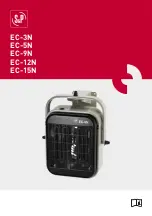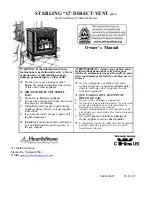
5
Read and Review this entire manual with special emphasis
on the Venting Sections (Pages 8-12) and Operation Section
(Pages 14-17) prior to any installation work.
LOCAL INSTALLATION REGULATIONS
This water heater must be installed in accordance with these instructions,
local codes, utility company requirements and/or, in the absence of local
codes, the latest edition of the National Fuel Gas Code, ANSI Z223.1 in
the United States, or CGA/CAN B149 Installation Codes in Canada.
LOCATION
A. This water heater is of the direct vent design. All air for combustion
and all products of combustion are routed through the venting system,
directly from and to the outside of the building.
The water heater should be installed in a clean, dry location as close
as practical to the gas vent terminals. Long hot water lines should be
insulated to conserve water and energy. The water heater and water
lines should be protected from exposure to freezing temperatures.
B. A gas fired water heater should not be installed in a space where liquids
which give off flammable vapors are to be used or stored. Such liquids
include gasoline, LP gas (butane and propane), paint or adhesives and
their thinners, solvents or removers. Because of natural air movement
in a room or other enclosed space, flammable vapors can be carried
some distance from where their liquids are being used or stored. The
open flame of the water heater’s intermittent pilot or main burner can
ignite these vapors causing an explosion or fire which may result in
severe burns or death to those in range, as well as property damage.
For these reasons, installation of a gas fired water heater in a garage
is not desirable.
if a location in a garage is the only alternative, the gas water heater
should be installed so that the open flame of the pilot and main
burner are no less than 18 inches above the garage floor. The water
heater must be located or protected so it is not subject to physical
damage by moving vehicles or area flooding. Raising the gas fired
water heater will reduce BUT NOT eliminate the possibility of light-
ing the vapor of any flammable liquids which may be improperly
stored or accidentally spilled.
C. All models are certified for installation on combustible floors and in
alcoves. The minimum side and top clearance to walls and ceiling for
providing protection of combustible materials are shown on the water
heater’s rating label. A front clearance of 18 inches (46 cm) should be
provided for adequate inspection and servicing.
If the water heater must be installed on carpeting, place a metal or
wood panel beneath water heater extending beyond its full width and
depth at least 3 inches (7.6 cm) in all directions. If the water heater is
installed in an alcove, the entire floor must be covered by the panel.
The water heater should not be located in an area where leakage of
the tank or connections will result in damage to the area adjacent
to it or to lower floors of the structure. When such areas cannot be
avoided, it is recommended that a suitable catch pan, adequately
drained, be installed under the water heater. The pan mUST NOT
restrict the flow of combustion air flow to bottom of water heater.
NOTICE: Auxiliary catch pan installation MUST conform to the ap-
plicable local codes.
D. RESTAURANTS — If the water heater is to be installed in a restau-
rant or other location where the floor is frequently cleaned, it must be
elevated to provide at least six inches (15 cm) of clearance from the
floor to comply with NSF International recommendations.
E. CORROSIVE ATMOSPHERES — The heater should not be installed
near an air supply containing halogenated hydrocarbons. For example,
the air in beauty shops, dry cleaning establishments, photo processing
labs, and storage areas for liquid and powdered bleaches or swim pool
chemicals often contain such hydrocarbons. The air there may be safe
to breathe, but when it passes through a gas flame, corrosive elements
are released that will shorten the life of any gas burning appliance.
Propellants from common spray cans or gas leaks from refrigeration
equipment are highly corrosive after passing through a flame. The lim-
ited warranty is voided when failure of water heater is due to a corrosive
atmosphere. (Refer to the Certificate of Limited Warranty for complete
terms and conditions.)
introduction
WARNING
!
WARNING
!
CAUTION
!






































